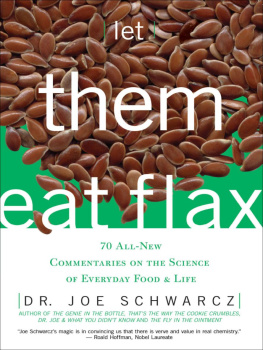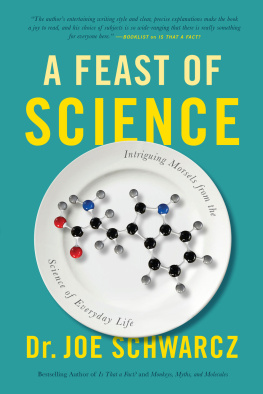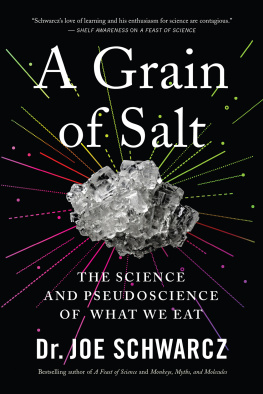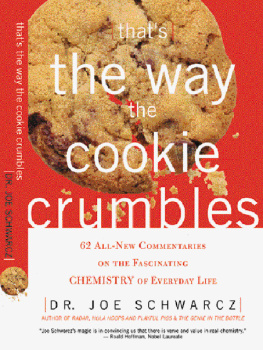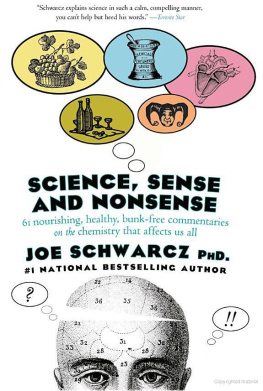CONTENTS
Naturally Occurring Substances in
Our Food Supply
Manipulating Our Food Supply
Contaminants in Our Food Supply
Tough to Swallow

It is a capital mistake to theorize before one has the data. Insensibly one begins to twist facts to suit theories, instead of theories to suit facts.
SHERLOCK HOLMES
Almost all aspects of life are engineered at the molecular level, and without understanding molecules we can only have a very sketchy understanding of life itself.
FRANCIS CRICK
INTRODUCTION
E ating used to be simple. As long as the food was tasty, looked reasonably appetizing and was plentiful, we were content. But then science came to dinner, and all of a sudden sitting down at the table became a laboratory experience, and a confusing one at that. Eat fish, we were told, its chock full of omega-3 fats. Be careful, urged another report, fish may harbor good fats, but its also loaded with PCBs and mercury. We switched to margarine from butter because it had fewer saturated fats. But then came accusations that the trans-fatty acids it contained clogged arteries just like saturated fats. Eat soy, we were told, it lowers your cholesterol. Dont eat soy, it affects thyroid function. Drink milk, you need the calcium. Dont drink milk, it forms mucus. Drink coffee, it is full of antioxidants. Dont drink coffee, it raises blood pressure. Then there are those little gems that they say. Stay away from MSG. Dont touch foods preserved with nitrites. Or with sulphites. Beware of pesticide residues. Ban foods that contain genetically modified organisms. Dont cook in Teflon pots. Or in microwave ovens. Stay away from sugar. And dont even think about artificial sweeteners! But just who are they? Weve been advised to load up on foods like oats, flax, mangosteen juice, garlic, and oregano because some researchers showed each of these to be of some benefit. Whole-grain bread may be in one daylots of useful fiber and vitaminsbut out the next because acrylamide, a purported carcinogen, was detected in the crust.
Many people throw up their arms in bewilderment at all this confusing nutritional information, and go back to their old dietary regimens. And that is too bad. Nutrition is important. The challenge is to separate the wheat from the chaff, and come to some practical conclusions about what to eat, based not on hearsay but on sound science.
This is not easy to do, especially when we consider that the human body is the most complex machine on the face of the earth. The diversity of its molecular components is so astounding that by comparison, computers, medical scanners, and space vehicles are simple devices. What we call life is really the result of astonishingly complex molecular activity that goes on in every cell in our body every second of the day. And where do the molecules that engage in these intricate gymnastics come from? One way or another, they come from the food we eat.
It seems obvious then that the composition of our diet can affect our molecular makeup, and consequently our health. But the relationship between diet and health is not a simple one. Food is chemically very complex. An apple, for example, is composed of over 300 different compounds. A single meal can flood the body with thousands of compounds, many of which have never been isolated or identified. While nutrition is obviously an important determinant of health, it is folly to think that one can introduce something as complicated as food into something as complex as the human body and make easy predictions about the outcome. Curing disease by dietary manipulation must therefore be looked at with a healthy degree of skepticism. But preventing disease by modifying our diet is realistic. The question is: how?
Separating sense from nonsense has been the focus of my educational activities ever since I began teaching chemistry back in 1973. This book does not purport to be an encyclopedia of nutrition or a comprehensive guide to healthy eating. It does, however, provide a framework for sound nutritional thinking, along with a perspective on what is worth worrying about and what is not as we ply ourselves with the mlange of molecules we call food.
People have different appetites when it comes to sampling food issues. Some are interested in the nutritional merits of specific foods; some are fascinated by the action of antioxidants; and others worry about the safety of additives. Chances are that most of you will be as picky with this book as you are with your food. Each of the chapters in this volume has been designed to stand on its own and to provide you with up-to-date information on a specific food-related issue. In Part One, we examine the role played by foods natural components. What is there in tomatoes, soy, or broccoli that can contribute to good health? Why does gluten in wheat cause problems for some people? Part Two investigates the consequences of human intervention in our food supply. What are the risks and benefits of food additives or of genetic modification? What promise lies in adding specific bacteria to foods? Part Three deals with substancessuch as pesticide residues, remnants of antibiotics, trans fats, and chemicals from plasticsthat end up in our food supply unintentionally as a result of food processing. And for good measure, after youve waded through the science, in Part Four, well throw in a discussion of some dubious nutritional ideas.
These are all fascinating issues. Now, on to the fun part: lets try to digest them.

NATURALLY OCCURRING SUBSTANCES IN OUR FOOD SUPPLY
AN APPLE A DAY
I s there a better subject with which to begin a discussion of the relationship between food and health than apples? After all, doesnt an apple a day keep the doctor away? Maybe it does, if you throw it at her! There is no single food that has magical health properties. There are good diets and there are bad diets. It is certainly possible to have a good diet and never eat apples, just as it is possible to gorge on apples and have a horrible diet. What really matters in terms of nutrition is the net effect produced by all of the chemicals that wend their way into our bodies from the food we eat. Yes, chemicals. I can practically see those eyebrows being raised. It may seem unusual to see the word chemical without an adjective like poisonous , in front of it. Actually, without appropriate context, toxic chemical is a meaningless term.
Take salicylic acid as an example. It occurs naturally in a variety of fruits and plants, including apples. It is also formed in our body when aspirin is metabolized. Indeed, salicylic acid is responsible for the physiological effects of aspirin, which include reducing the risk of blood-clot formation. Thats why aspirin is used to treat a heart attack, and why it is commonly taken in small doses to prevent one. But in an overdose, salicylic acid can kill. Before childproof packaging was introduced, aspirin poisoning was a common cause of death in children. So how do we react if a test detects salicylic acid in our blood? Panic because of the presence of a toxic chemical, or relief because of possible protection against heart disease? Of course, without the proper context there can be no appropriate reaction. To decide whether to laugh or cry, we need to know what blood levels of salicylic acid have been linked to risk and what levels to protection from disease. The mere presence of the chemical says nothing. As Paracelsus insightfully and wisely noted some 500 years ago, Only the dose makes the poison. And to this we can add, And only the dose makes the cure!
Next page



